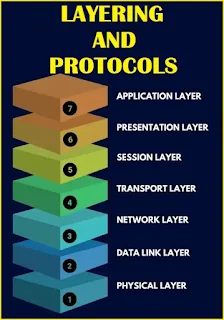LAYERING AND PROTOCOLS
Layering, in the context of networking and communication systems, refers to the organization of complex systems into multiple, hierarchical layers, each with specific functions and responsibilities. This concept is essential for modular design and interoperability. The most common layered model in networking is the OSI (Open Systems Interconnection) model, which has seven layers:
PROTOCOLS
Protocols are a set of rules and conventions that determine how data is exchanged and communicated between devices or systems.
They provide a standardized way for various entities to understand and interact with each other.
Protocols operate at specific layers of the network stack, ensuring that each layer's functionality is well-defined and can operate independently of the layers above and below.
INTERNET PROTOCOLS
HTTP (Hypertext Transfer Protocol)-Used for transmitting web pages and other resources over the World Wide Web.
HTTPS (Hypertext Transfer Protocol Secure)-An encrypted version of HTTP, ensuring secure communication for activities such as online banking and e-commerce.
TCP / IP (Transmission Control Protocol / Internet Protocol)- The backbone of the internet and most networks, TCP/IP provides a reliable and connection-oriented method for data transmission. It includes protocols like TCP (for reliable data delivery) and IP (for routing and addressing).
NETWORK PROTOCOLS
Ethernet- A protocol that defines how data is placed over a physical network medium, such as via wired connections.
IPv4 and IPv6- Internet Protocol versions 4 and 6, respectively, used to route data packets across networks.
COMMUNICATION PROTOCOLS
SMTP (Simple Mail Transfer Protocol): Used for sending and receiving email.
POP3 (Post Office Protocol 3) and IMAP (Internet Message Access Protocol): Protocols used by e-mail clients to retrieve messages from mail servers.
FILE TRANSFER PROTOCOLS
FTP (File Transfer Protocol): Used for transferring files between a client and a server on a computer network.
APPLICATION LAYER PROTOCOLS
DNS (Domain Name System)- Converts human-readable domain names into IP addresses to facilitate internet navigation.
SNMP (Simple Network Management Protocol)- Used for managing and monitoring network devices and their performance.
WIRELESS PROTOCOLS
Bluetooth- A short-range wireless protocol used for connecting devices such as smartphones, keyboards, and headphones.
Wi-Fi- A protocol for wireless local area networking, enabling devices to connect to the Internet and other devices within a specified area.
SECURITY PROTOCOLS
TLS/SSL (Transport Layer Security / Secure Sockets Layer)- Protocols that provide secure communication over a computer network, commonly used for web browsing.
Physical Layer Protocols: Examples include Ethernet and Wi-Fi standards, which define how data is transmitted over physical media.
Data Link Layer Protocols: Ethernet and Wi-Fi also operate at this layer, along with protocols like ARP (Address Resolution Protocol) for mapping IP addresses to MAC addresses.
Network Layer Protocols: Internet Protocol (IP) is a prominent example, used for addressing and routing packets across networks. Additionally, ICMP (Internet Control Message Protocol) handles network management tasks like ping and trace route.
Transport Layer Protocols: TCP (Transmission Control Protocol) ensures reliable, connection-oriented communication, while UDP (User Datagram Protocol) offers connectionless, lightweight communication.
Application Layer Protocols: These include HTTP for web browsing, SMTP for email, and FTP for file transfer, among many others.

